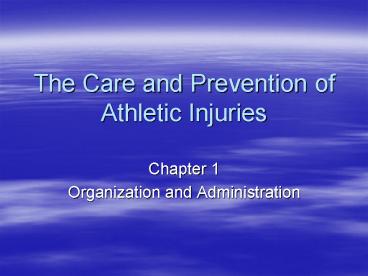The Care and Prevention of Athletic Injuries - PowerPoint PPT Presentation
1 / 24
Title:
The Care and Prevention of Athletic Injuries
Description:
The Care and Prevention of Athletic Injuries Chapter 1 Organization and Administration Since 1960 s, the National Athletic Trainers Association (NATA) has ... – PowerPoint PPT presentation
Number of Views:1066
Avg rating:3.0/5.0
Title: The Care and Prevention of Athletic Injuries
1
The Care and Prevention of Athletic Injuries
- Chapter 1
- Organization and Administration
2
- Since 1960s, the National Athletic Trainers
Association (NATA) has established high standards
for the education and certification of ATs. - The American Medical Association (AMA)
recognized athletic training as an allied health
profession in 1990.
3
ATs need a thorough knowledge in -Anatomy. -Phy
siology. -Exercise physiology. -Psychology. -Fi
rst aid. -CPR. -Nutrition. -Basic exercise.
4
Courses taken by AT students
- -Anatomy and physiology.
- -Exercise physiology.
- -Kinesiology.
- -Biomechanics.
- -Personal Health.
- -Basic Athletic Training.
- -Advanced Athletic Training.
5
The Sports Medicine Team
- -Duties and responsibilities of each member of
the team are interrelated.
6
The Sports Medicine Team
Parents
Officials
Athlete
Coaches
Athletic Trainers
7
Athletes
- -Must keep in good physical conditions.
- -Must follow team rules.
- -Must follow instructions of the coaches and
athletic trainer.
8
Parents
- -Assist in keeping athlete healthy.
9
Officials
- -Enforce rules, monitor play, and cooperate with
athletic trainer and coach when injuries occur.
10
Coaches
- -Plan practices (Conditioning/Tactical/Tech.)
- -Protective equipment.
- -Supervision of practices/games.
- -Stay educated (Clinics/CPR/First Aid).
- -Place athletes welfare foremost.
- -Accident reports.
11
Athletic Trainer
- -Serves as liaison between coach, parent, and
athlete. - -Maintain contact with coach and parents
regarding athletes injuries. - -Improve conditioning level of team during
off-season.
12
Athletic Trainer cont
- -Provide first aid, basic treatments, and
rehabilitation programs. - -Inventorying/ordering/
- purchasing supplies.
- -Accident reports.
13
Student Athletic Trainer Roles and
Responsibilities
- -Roles and responsibilities are limited.
- -Maintaining a clean athletic training
room/facility. - -Inventory control.
- -Checklist of supplies to have on field/court for
games/practices.
14
Student AT Roles Responsibilities cont
- -Pack med kit.
- -Preparing ice/water buckets for athletes.
- -Record keeping duties (weight, etc.).
- -Taping, wrapping, changing dressing when ready.
- -LEARN!
15
Training Room
- -Sizes vary.
- -Include -Electrical therapy.
- -Hydrotherapy (heat and cold appl.)
- -Taping.
- -Rehabilitation.
- -Administrative office.
- -Physicians examination office.
- -Storage room/closet.
- -Supplies (List on pg. 5).
16
Training Room Rules
- -Outline of services offered.
- -Open/Closed time.
- -Conduct.
- -Review common rules on pg. 7.
17
Record Keeping
- Careful records of an athlete.
- Accident-injury reports.
- Weight charts.
18
Athletes Bill of Rights
- Every athlete is entitled to adequate conditions
and other injury prevention measures, proper
treatment of injuries, and complete
rehabilitation.
19
Athletic Trainers What they need
- -Professional skills.
- -Knowledge in athletic training.
- -Enjoyment of athletes.
- -Interested in each athletes well being.
- -Good fitness and personal health.
- -Common sense.
20
Recognition, Evaluation, and Management
- Chapter 2
21
Recognition of Injury
- Recognition is the first step in the injury
process. - Primary function of an AT is to recognize when an
injury has occurred and how to evaluate the
security of the injury. - AT determines how it happens and the probable
cause of the injury through direct observation,
or second hand accounts.
22
Evaluation Format
- H.O.P.S.
- History how did the injury occur, location of
pain, sensations felt, and previous injury. - Observation Look for swelling, discoloration
(Ecchymosis), deformity, or other signs of
trauma. - Palpation Touch injured site, compare
bilaterally. - Stress Tests Perform assessment tests, evaluate
joint stability.
23
Treatment of Injuries
- P.R.I.C.E.S.
- Protection protect site from further damage.
- Rest remove athlete from competition.
- Ice apply ice for 20 min, 6-8 times per day.
- Compression elastic wrap to control swelling.
- Elevation elevate site above heart, let gravity
help pull out fluid. - Support crutches, splints, neck braces, etc.
24
- Role of person applying first aid
- Prevention of further injury.
- Reducing pain.
- Stabilizing the injury.
- The Primary role of the athletic trainer is the
care and prevention of athletic injuries. - If athlete is untreated during the inflammation
process, recovery will take longer than if the
injury is aggressively treated.











![[PDF] Fixing Your Feet: Injury Prevention and Treatment for Athletes Paperback – November 9, 2021 Full PowerPoint PPT Presentation](https://s3.amazonaws.com/images.powershow.com/10077889.th0.jpg?_=20240712094)



















